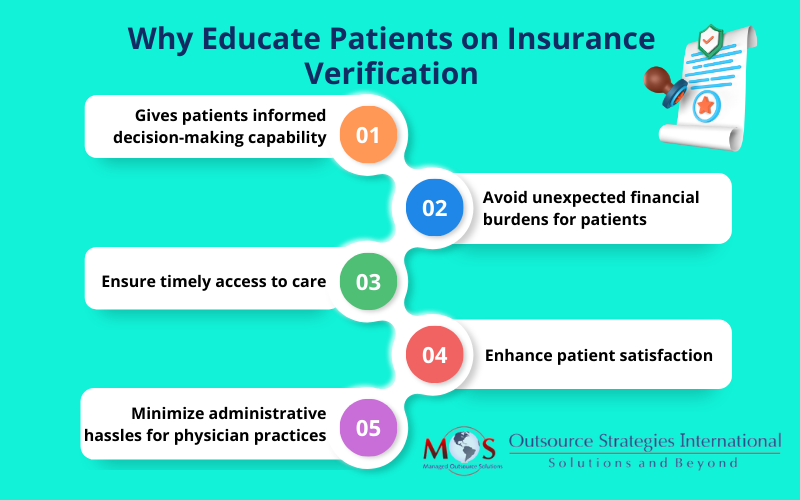Educating patients about insurance eligibility checks in healthcare is key for patients to navigate the system successfully. Patient out-of-pocket costs are increasing and many patients face higher coinsurance, bigger co-pays, and very high deductibles, so educating patients on insurance coverage verification is more important than ever for both patients and healthcare providers.


Find out more about insurance verification services available for your specialty!
Why Educate Patients on Insurance Eligibility Checks?
Why you Need to Educate Patients on Insurance Verification
The following points help establish why beneficiaries need to be educated regarding verification of patient benefits.
- Benefits them with informed decision-making capability: Educating patients about insurance eligibility checks helps them make informed decisions regarding their healthcare. Understanding what services are covered by their insurance plan is vital for patients to plan and budget for their medical expenses effectively.
- Helps avoid unexpected financial surprises: Lack of awareness about insurance coverage can result in unexpected financial burdens for patients. By educating patients about the importance of verifying insurance coverage, healthcare providers can help prevent billing discrepancies and surprise out-of-pocket expenses.
- Facilitates timely access to care: Patients who are well-informed about their insurance coverage are more likely to seek timely health care when needed. Educating patients on the process of verifying insurance coverage can expedite the pre-authorization process, ensuring that necessary treatments or procedures are not delayed due to insurance-related issues.
- Helps improve patient satisfaction: Providing transparent information about insurance coverage will definitely improve patient satisfaction. When patients understand their insurance benefits and coverage limitations upfront, they are less likely to experience frustration or confusion during the billing process. This ultimately contributes to a positive healthcare experience and fosters trust between patients and providers.
- Minimizes administrative burden: Educating patients on insurance coverage verification can help minimize the administrative burden on healthcare providers. When patients are proactive in verifying coverage, it reduces the need for providers to spend considerable time resolving billing issues or obtaining retroactive authorizations. This in turn enables them to focus more on delivering quality care.
- Helps address common insurance pitfalls: Patients often face common pitfalls when navigating insurance coverage, such as understanding deductibles, copayments, and coverage limitations. Educating patients about these aspects can help them avoid potential financial pitfalls and make informed decisions about their healthcare utilization.

Ready to expand your knowledge?
Explore insights on patient communication and insurance verification
Effective Communication Strategies to Use
Effective communication is key to educating patients. Healthcare providers should clearly explain the importance of insurance eligibility checks and the steps involved in the verification process.
- Utilize patient educational materials successfully: You can provide patients with educational materials, such as brochures or online resources. These materials should be easy to understand and accessible to patients of diverse backgrounds and literacy levels. Take the case of a primary care clinic that has noticed an increase in patient inquiries regarding insurance coverage and billing concerns. In response, the clinic decides to develop and distribute patient education materials focused on insurance coverage verification. These materials include the following.
- Brochure: The clinic creates a brochure titled “Understanding Your Insurance Coverage: A Guide for Patients.” It describes the importance of verifying insurance coverage and provides step-by-step instructions on how patients can check their coverage status. Information on common insurance terms – deductibles, copayments, and out-of-pocket maximums – is clearly provided to help patients better understand their coverage benefits.
- Online resources: The clinic updates its website to include a dedicated section on insurance coverage education. Downloadable versions of the brochure are uploaded, alongside other useful resources such as FAQs and links to reputable insurance information websites. Patients can access these resources at their convenience and refer to them whenever they have any questions about their insurance coverage.
- Waiting room materials: Copies of the brochure are printed and placed in the waiting room. The clinic also displays posters and flyers highlighting key points and encouraging patients to ask questions if they need assistance.
- Staff training: The clinic provides training sessions for its staff to ensure they are equipped to assist patients with all insurance coverage-related questions. Front desk staff are trained to distribute the materials and answer basic questions about insurance coverage verification. The clinical staff are also briefed on how to address patient concerns during appointments and provide referrals to financial counseling services if needed.
- Follow-up communication: After the patient visit, the clinic sends out automated follow-up emails containing links to the online resources and reminders for patients to review their insurance coverage. Patients are encouraged to contact the clinic if they have any questions or need further assistance. This hands-on communication encourages patients to take an active role in managing their healthcare finances.
- Providing help and support: Healthcare staff should help and support patients who may need assistance in navigating insurance-associated concerns. They can answer questions about coverage details, help patients fill out insurance forms, or connect patients with financial counseling services if required.
- Emphasizing Patient Responsibility: Encouraging patients to take an active role in verifying their insurance coverage reinforces the importance of personal responsibility in managing healthcare finances. By empowering patients to advocate for themselves, healthcare providers can promote patient engagement and accountability.
Reduce the risk of claim denials with OSI’s insurance verification services.
Ask us for a free trial!
Get in touch with us today @ (800) 670-2809Some Points to Bear in Mind
Insurance coverage details may change over time due to policy updates, job changes, or life events. Encouraging patients to regularly review and update their insurance information ensures that they have accurate coverage information on file, preventing potential claim denials or coverage gaps.
Healthcare providers can leverage technology to streamline the insurance verification process and enhance patient education. Online patient portals, mobile apps, and automated appointment reminders can be utilized to communicate important insurance-related information to patients and facilitate efficient verification processes.
Establishing collaborative relationships with insurance providers can facilitate smoother insurance verification processes for patients. Healthcare providers can work closely with insurance companies to provide patients with accurate information about in-network providers, covered services, and pre-authorization requirements.
Following up with patients can provide an opportunity to address any remaining questions or concerns. Additionally, requesting feedback from patients about their experiences with the process can help healthcare providers identify areas for improvement and thus enhance patient satisfaction.
Patient Education a Key Aspect of Patient-centered Care
Educating patients about insurance coverage verification is a fundamental aspect of patient-centered care. By equipping patients with the knowledge and resources to understand their insurance benefits and navigate the verification process, healthcare providers can improve patient outcomes, enhance satisfaction, and promote financial transparency in healthcare delivery. Investing in patient education is an investment in empowering patients to take control of their healthcare journey.






